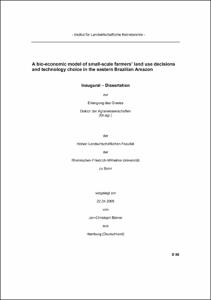Börner, Jan-Christoph: A bio-economic model of small-scale farmers’ land use decisions and technology choice in the eastern Brazilian Amazon. - Bonn, 2006. - Dissertation, Rheinische Friedrich-Wilhelms-Universität Bonn.
Online-Ausgabe in bonndoc: https://nbn-resolving.org/urn:nbn:de:hbz:5N-07475
Online-Ausgabe in bonndoc: https://nbn-resolving.org/urn:nbn:de:hbz:5N-07475
@phdthesis{handle:20.500.11811/2362,
urn: https://nbn-resolving.org/urn:nbn:de:hbz:5N-07475,
author = {{Jan-Christoph Börner}},
title = {A bio-economic model of small-scale farmers’ land use decisions and technology choice in the eastern Brazilian Amazon},
school = {Rheinische Friedrich-Wilhelms-Universität Bonn},
year = 2006,
note = {A great deal of more recent agricultural research in the Brazilian Amazon region has been focusing on the ‘hot spots’ of deforestation at the forest margins. Small-scale agriculturalists represent the largest group of the rural population and, apart from contributing to the high deforestation rates, are among the most affected by the environmental consequences of land use and land cover change in the Amazon region. This study attempts to contribute to the current debate on the sustainability of smallholder agriculture by focusing on one of the oldest colonization areas in the Brazilian Amazon region, the Zona Bragantina.
An additional motivation for the study was the emergence of technological alternatives to the traditional land preparation technique slash-and-burn. Some of these alternatives appear promising in that they could contribute to reducing the social costs of slash-and-burn that accrue mainly in the form of greenhouse gas emissions and material damages from accidental fires.
The study adopts a neo-classical theoretical framework of farm-household behavior that explicitly addresses the links between poverty and the environment. A descriptive analysis of secondary and primary data using standard statistical tools, such as difference of mean tests and regression analysis, provides the background for a formal quantitative analysis that draws on linear and non-linear mathematical programming and accounts for the existence of market and production risks.
It was found that smallholder agriculture in the Bragantina is likely to further contribute to natural resource degradation in the form of greenhouse gas emissions and fallow degradation. However, this does not necessarily imply significant negative effects on household consumption levels, especially in the presence of technological change.
Given that natural resources provide not only private but also social services, policy measures are tested with respect to their effectiveness in improving environmental indicators without halting economic and technological development. Among the typical environmental policy measures, taxes and conservation payments are promising candidates to improve environmental indicators and address regional development heterogeneities in an economically optimal way. In addition, the option of a technology-specific crop yield insurance provides a means to increase the competitiveness of slightly more expensive but ecologically advantageous technologies.
Existing agro-environmental policy measures, such as the upcoming credit program Proambiente, were simulated in order to derive recommendations for further fine-tuning. Regarding Proambiente it was found that the program regulations are too restrictive with regard to the use of chemical fertilizers. The model suggests that relaxing some of these restrictions will greatly improve the chances for the program to become attractive to smallholders in the Bragantina.},
url = {https://hdl.handle.net/20.500.11811/2362}
}
urn: https://nbn-resolving.org/urn:nbn:de:hbz:5N-07475,
author = {{Jan-Christoph Börner}},
title = {A bio-economic model of small-scale farmers’ land use decisions and technology choice in the eastern Brazilian Amazon},
school = {Rheinische Friedrich-Wilhelms-Universität Bonn},
year = 2006,
note = {A great deal of more recent agricultural research in the Brazilian Amazon region has been focusing on the ‘hot spots’ of deforestation at the forest margins. Small-scale agriculturalists represent the largest group of the rural population and, apart from contributing to the high deforestation rates, are among the most affected by the environmental consequences of land use and land cover change in the Amazon region. This study attempts to contribute to the current debate on the sustainability of smallholder agriculture by focusing on one of the oldest colonization areas in the Brazilian Amazon region, the Zona Bragantina.
An additional motivation for the study was the emergence of technological alternatives to the traditional land preparation technique slash-and-burn. Some of these alternatives appear promising in that they could contribute to reducing the social costs of slash-and-burn that accrue mainly in the form of greenhouse gas emissions and material damages from accidental fires.
The study adopts a neo-classical theoretical framework of farm-household behavior that explicitly addresses the links between poverty and the environment. A descriptive analysis of secondary and primary data using standard statistical tools, such as difference of mean tests and regression analysis, provides the background for a formal quantitative analysis that draws on linear and non-linear mathematical programming and accounts for the existence of market and production risks.
It was found that smallholder agriculture in the Bragantina is likely to further contribute to natural resource degradation in the form of greenhouse gas emissions and fallow degradation. However, this does not necessarily imply significant negative effects on household consumption levels, especially in the presence of technological change.
Given that natural resources provide not only private but also social services, policy measures are tested with respect to their effectiveness in improving environmental indicators without halting economic and technological development. Among the typical environmental policy measures, taxes and conservation payments are promising candidates to improve environmental indicators and address regional development heterogeneities in an economically optimal way. In addition, the option of a technology-specific crop yield insurance provides a means to increase the competitiveness of slightly more expensive but ecologically advantageous technologies.
Existing agro-environmental policy measures, such as the upcoming credit program Proambiente, were simulated in order to derive recommendations for further fine-tuning. Regarding Proambiente it was found that the program regulations are too restrictive with regard to the use of chemical fertilizers. The model suggests that relaxing some of these restrictions will greatly improve the chances for the program to become attractive to smallholders in the Bragantina.},
url = {https://hdl.handle.net/20.500.11811/2362}
}






